The easiest way to experience Outer Banks wildlife is to walk along any beach and check out the birds because there are many of them. Gulls, pelicans, willets…they are so inescapable that they seem like they’re not even there.
All of them though, are part of life on the Outer Banks, and they offer a glimpse into the natural world surrounding us.
Outer Banks Beach Birds
Brown Pelican
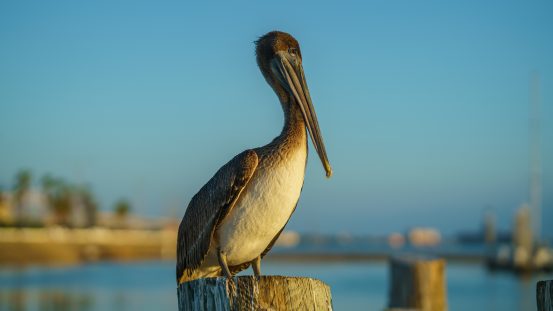
Watching a Brown Pelican galumph along as it walks in one of its rare forays onto land, or even just looking at it when it’s perched on a pier piling, there is the thought that surely this is one of the world’s most clumsy creatures.
But in flight, the brown pelican is transformed into a beautiful flying machine.
They are migrating birds, leaving the area in the winter, so the most likely time to see them is in spring, summer, and fall.
The Brown Pelican wingspan can be up to six and one-half feet, and they are marvelously efficient flyers, gliding just above the water. They take their prey, though, with spectacular dives into the water from 50’ or 60’.
Willet
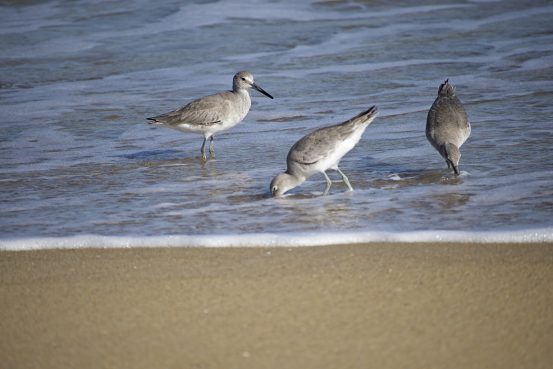
That bird with the dusty brown and white feathers and long legs that are always running at the end of waves as they roll up on the beach is a Willet.
They’re kind of fun to watch. As soon as the water retreats and exposes the wet sand, they start pecking at it, looking for a meal of ghost crab or sand fleas.
In flight, their wings show a beautiful black and white pattern.
Willets were almost hunted to extinction before the migratory bird act of 1918 prohibited hunting them. The feathers were used for decoration, and the bird and its eggs were considered a delicacy.
Sanderling
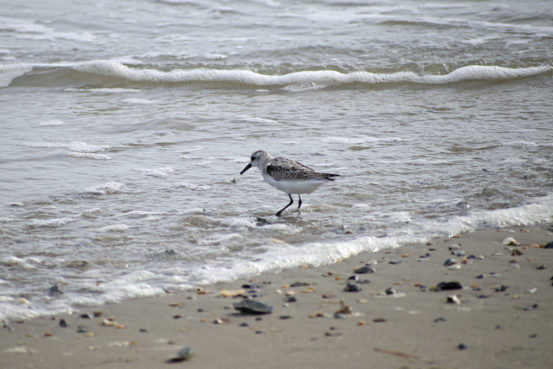
The sanderling is a slightly chunkier version of the Willet. It is a highly migratory bird, nesting and breeding in the tundra of Canada and Alaska, then taking a winter break on Outer Banks beaches.
Coloration and behavior are similar to the Willet.
Gulls
Herring Gull
A very common gull along the Outer Banks, the Herring Gull looks a lot like the Ring-billed Gull. The easiest way to tell them apart is the color of their legs. The Herring Gull has gray legs; the ring-billed gull yellow legs.
Herring Gulls are on the Outer Banks year-round. Actually, they’re almost everywhere year-round. Beaches, mudflats, landfills—they’re not very picky.
Ring-Billed Gull
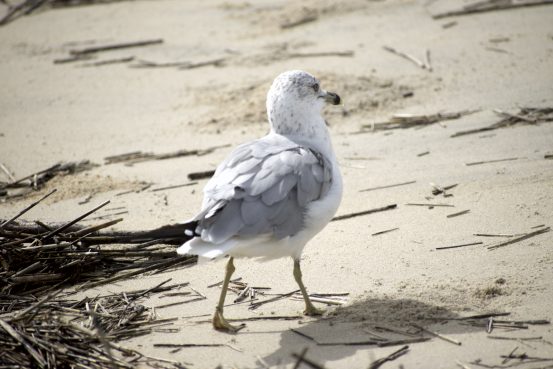
There’s a good chance that the gulls gathered by the 100s on a beach walk are Ring-billed Gulls. One of the characteristics of the bird is that it likes to congregate on the beach or just about anywhere it can get together.
A very graceful bird in flight, its wing feather extend past the end of its tail when not in flight.
Lesser Black-backed Gull
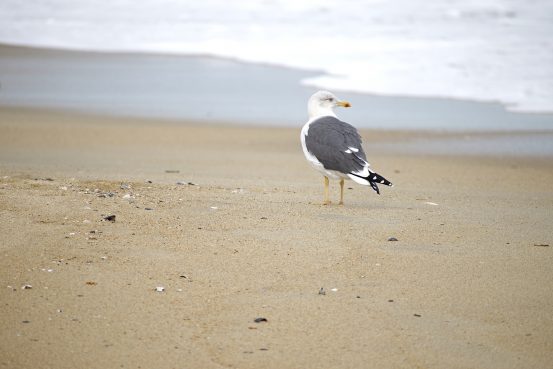
At one time, the lesser black-backed gull was found almost exclusively in Europe. Over the past 60 or 70 years, it has shown up increasingly along the Atlantic seaboard, and it’s not all that rare to see one in the winter on the Outer Banks.
The Outer Banks visitors are probably coming from Iceland and Greenland after their summer breeding season.
Laughing Gull
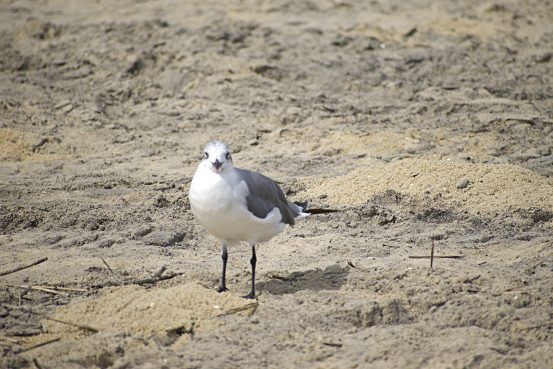
A noisy medium-sized gull, Laughing Gulls, will forage for just about anything edible. There is a striking difference in appearance between summer, when they’re breeding, and winter. Breeding adults have a black head with a red beak. Non-breeding Laughing Gulls have an off-white head with a dark gray or black beak.
Black-Backed Gull
Black-backed gulls are the largest gull in the world. Fairly common along the East Coast, the easiest way to identify them is by their size. They can also be a bit of a bully at times, chasing other birds away from food.
Shorebirds On The Soundside Of The Outer Banks
Great Blue Heron

The largest bird in the heron family, Great Blue Herons wade into shallow water then wait patiently for its prey to swim by.
Striking in appearance, adult birds are blue-gray with a black stripe over the eyes and a noticeably pointed bill.
Great Egret
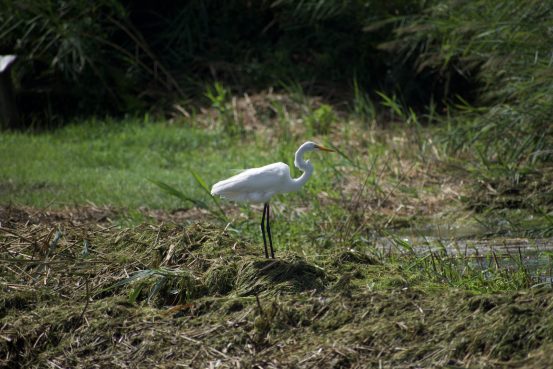
With its pure white feathers and trim—svelte—body, the Great Egret is one of the Outer Banks’ most beautiful birds. It hunts its prey much like the Great Blue Heron, although it does swim after a meal from time to time.
Its magnificent plumage was almost its undoing. Until market hunting for plumage was outlawed in 1918, the Great Egret was almost hunted to extinction.
Cattle Egret
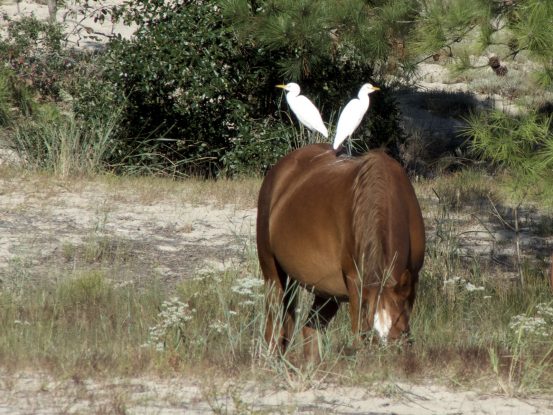
Originally from Africa, the Cattle Egret seems to have hitched a ride to South America toward the end of the 19th century. It then spread north and is now a common sight around livestock and large mammals throughout the United States.
It is a stocky, medium-sized bird. The Corolla Wild Horses don’t mind giving them a ride because they pick ticks off the horses’ backs. Cattle Egrets also forage at the horses’ feet, eating the invertebrates that are brought to the surface during grazing.
They’re here but you probably won’t see them
Piping Plover
Piping plover came dangerously close to ceasing to exist as a species. As a result, extraordinary measures have been put in place to protect the species. Approaching a nesting area on federal land is strictly prohibited.
The Piping Plover is a small bird that is sand-colored, much like its environment.
The Outer Banks is at the southern end of its range, and it is unclear how many had initially made the area their home.
American Oystercatcher
A beautiful bird with a black head and red beak, the American Oystercatcher lives exclusively on shellfish. They were more common at one time, but the loss of habitat seems to have reduced their number.
Least Tern

A very fast flyer that makes quick dives into the water, the Least Tern is the smallest of terns.
There is a chance that one can be seen, but look quickly because it’s there and gone.
They nest and breed in the spring and summer on the Outer Banks, so that’s the best chance to see them.
This is very much a partial list of shorebirds. Grab a camera, or a cell phone and go explore.
